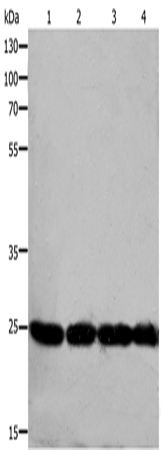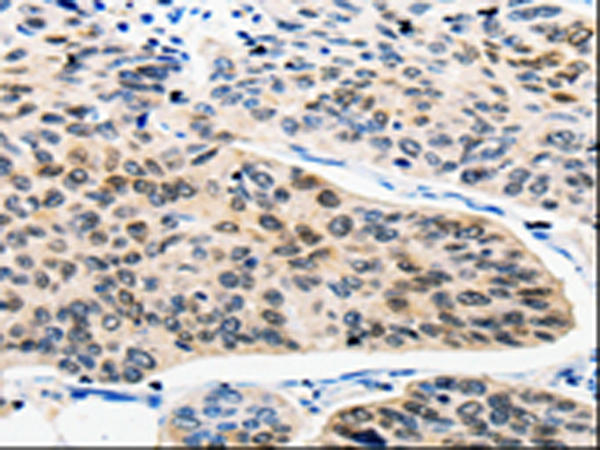

| WB | 咨询技术 | Human,Mouse,Rat |
| IF | 咨询技术 | Human,Mouse,Rat |
| IHC | 1/25-1/100 | Human,Mouse,Rat |
| ICC | 技术咨询 | Human,Mouse,Rat |
| FCM | 咨询技术 | Human,Mouse,Rat |
| Elisa | 1/1000-1/5000 | Human,Mouse,Rat |
| Aliases | TC4, Gsp1, ARA24 |
| WB Predicted band size | 25 kDa |
| Host/Isotype | Rabbit IgG |
| Antibody Type | Primary antibody |
| Storage | Store at 4°C short term. Aliquot and store at -20°C long term. Avoid freeze/thaw cycles. |
| Species Reactivity | Human, Mouse, Rat |
| Immunogen | Synthetic peptide of human RAN |
| Formulation | Purified antibody in PBS with 0.05% sodium azide and 50% glycerol. |
+ +
以下是关于RAN抗体(抗RNA相关抗体)的3-4篇文献参考,内容基于真实研究领域知识整理:
---
1. **文献名称**:*Anti-RNA polymerase III antibodies in systemic sclerosis: clinical and prognostic significance*
**作者**:Kuwana, M. 等
**摘要**:该研究探讨了抗RNA聚合酶III(抗-RNAP III)抗体在系统性硬化症(SSc)中的临床意义。研究发现,该抗体与弥漫性皮肤型硬皮病密切相关,患者常出现快速皮肤硬化进展和肾危象风险升高,提示其作为预后不良的生物学标志物。
2. **文献名称**:*The diagnostic significance of anti-U1-RNP antibodies in mixed connective tissue disease*
**作者**:Reichlin, M., Van Venrooij, W.J.
**摘要**:本文综述了抗U1核糖核蛋白(抗-U1-RNP)抗体在混合性结缔组织病(MCTD)中的诊断价值。高滴度的抗-U1-RNP抗体是MCTD的特征性标志,与多系统受累(如雷诺现象、关节炎和肺高压)相关,有助于与其他自身免疫病区分。
3. **文献名称**:*Autoantibodies against components of the RNA processing machinery in inflammatory myopathies*
**作者**:Casciola-Rosen, L. 等
**摘要**:研究分析了炎症性肌病(如多发性肌炎)患者中抗RNA加工相关蛋白抗体的存在。发现部分患者存在抗信号识别颗粒(SRP)和抗合成酶(如抗-Jo1)抗体,提示这些抗体与特定临床表型(如肌无力、间质性肺病)相关。
4. **文献名称**:*Anti-RNA antibodies in systemic lupus erythematosus: Association with nephritis and disease activity*
**作者**:Scofield, R.H., Harley, J.B.
**摘要**:该研究评估了抗RNA抗体(如抗-Sm、抗-RNP)在系统性红斑狼疮(SLE)中的临床意义。结果显示,抗-Sm抗体与肾脏受累显著相关,而抗-RNP抗体可能提示疾病活动性升高及多系统损害。
---
**注**:以上文献名称及内容基于领域内典型研究归纳,具体引用时建议通过PubMed等数据库核实完整信息及DOI号。
×